
Bretton Hall is a country house in West Bretton near Wakefield, West Yorkshire, England. It housed Bretton Hall College from 1949 until 2001 and was a campus of the University of Leeds (2001–2007). It is a Grade II* listed building.

The Portico Library, The Portico or Portico Library and Gallery on Mosley Street in Manchester, England, is an independent subscription library designed in the Greek Revival style by Thomas Harrison of Chester and built between 1802 and 1806. It is recorded in the National Heritage List for England as a Grade II* listed building, having been designated on 25 February 1952, and has been described as "the most refined little building in Manchester".

The Bar Convent Living Heritage Centre, at Micklegate Bar, York, England, established in 1686, is the oldest surviving Catholic convent in the British Isles. The laws of England at this time prohibited the foundation of Catholic convents and as a result of this, the convent was both established and operated in secret.

The Lamb Hotel, now known as Chatterton House, is a former public house in Nantwich, Cheshire, England. It is located on the north side of Hospital Street, at the junction with Church Lane. The present building by Thomas Bower dates from 1861 and is listed at grade II; Nikolaus Pevsner describes it as "decent" and "staid".
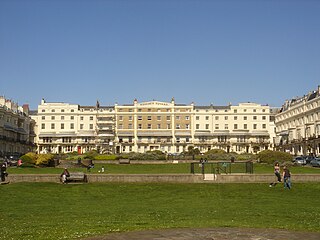
Regency Square is a large early 19th-century residential development on the seafront in Brighton, part of the British city of Brighton and Hove. Conceived by speculative developer Joshua Hanson as Brighton underwent its rapid transformation into a fashionable resort, the three-sided "set piece" of 69 houses and associated structures was built between 1818 and 1832. Most of the houses overlooking the central garden were complete by 1824. The site was previously known, briefly and unofficially, as Belle Vue Field.
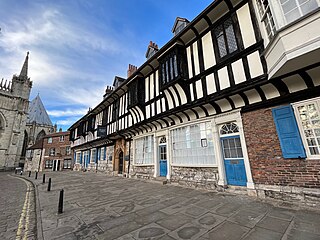
St William's College is a Mediaeval building in York in England, originally built to provide accommodation for priests attached to chantry chapels at nearby York Minster. It is a Grade I listed building.
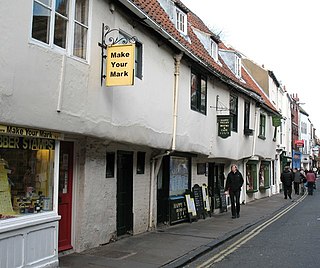
Lady Row, also known as Our Lady's Row, is a mediaeval Grade I listed building on Goodramgate in York, England. Historic England describe the structure as "some of the earliest urban vernacular building surviving in England".

Sir Thomas Herbert's House, often known as Herbert House, is a Grade I listed building in York, dating from the 16th and 17th centuries.

The Blue Bell is a historic pub in the city centre of York, England. The pub lies on the south-west side of Fossgate.

The Dutch House is a historic house, lying on Ogleforth, in the city centre of York, England.

Harkers is a pub in the city centre of York, in England.
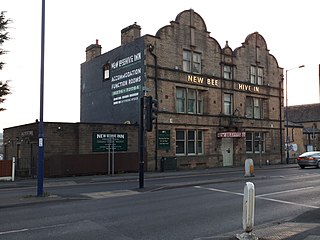
The New Beehive Inn is a former pub in Bradford, England. It was built by Bradford Corporation in 1901 to replace an existing public house of the same name that they had purchased in 1889 and demolished to widen a road. The corporation intended to run the pub itself but instead let it out and sold it in 1926. It has since been run by a number of brewery companies and individuals. The pub contained many features dating to its construction and a significant refurbishment in 1936 and was described by the Campaign for Real Ale as "one of the country's very best historic pub interiors".

Ye Olde White Harte is a public house in Hull, England. It was built around 1660 in the Artisan Mannerist style but did not become a pub until the 1730s. In the aftermath of the Glorious Revolution of 1688 it was the site of a successful plot to remove the Catholic Governor of Hull. The pub was remodelled in 1881 in the Romantic style with extensive alteration to the interior and façade. At least two residents have suffered fatal accidents in the pub and it is reputed to be "one of Hull's most haunted".

The Golden Ball is a pub in the Bishophill area of central York, in England.

36–42 Coney Street is a historic terrace in the city centre of York, in England.
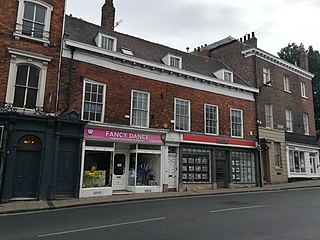
33–37 Micklegate is a historic building in the city centre of York, in England.

2–2A High Petergate is an historic building in York, England. A Grade II listed building, it stands adjacent to Bootham Bar at the opposite end of High Petergate from York Minster. It was built around 1840; a shopfront was added the following century.

The Old Rectory is a historic building in the city centre of York, in England.
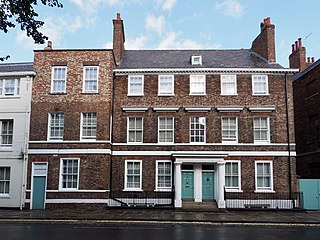
53 and 55 Bootham is a historic building on Bootham, immediately north of the city centre of York, in England.

The Garth is a historic building on Marygate, immediately north of the city centre of York, in England.




















